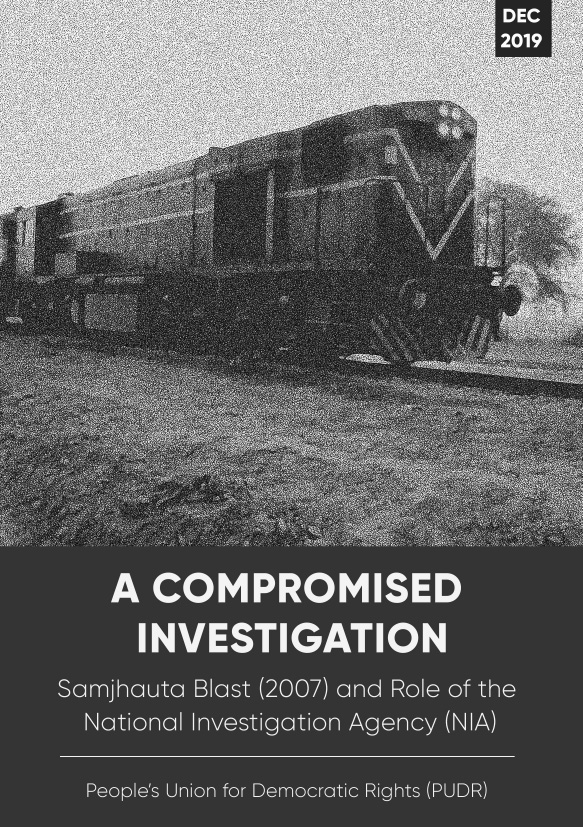 In March 2019, the NIA Special Court, Panchkula delivered the verdict in the Samjhauta Blast Case of 2007, which had killed 67 and injured 13 passengers, mostly Pakistani citizens, aboard the Attari Express near Panipat. The Samjhauta blasts were uncovered as part of a series of alleged Hindutva terror attacks on Muslim places of worship and areas with high concentration of Muslim population, such as the Ajmer and Mecca Masjid blast cases. On trial for the Samjhauta blast were Swami Aseemanand, Ramchandra Kalsangra, Sandeep Dange, Lokesh Sharma, Kamal Chouhan, Rajendra Chaudhary and Amit Hakla, all associated with different Hindutva terror outfits. They had been charged under provisions relating to sedition, criminal conspiracy etc. under the IPC, and also under the UAPA for unlawful and terrorist activity, raising funds, conspiracy, enhanced penalties, among other laws. After three years of investigations by the Karnal Railway Police and a Special Investigative Team (SIT) pursuing links to the LeT and SIMI, in 2010 the case was transferred to the National Investigating Agency (NIA) when Maharashtra ATS investigations into the Malegaon blasts indicated wide links to the same terror outfits.
In March 2019, the NIA Special Court, Panchkula delivered the verdict in the Samjhauta Blast Case of 2007, which had killed 67 and injured 13 passengers, mostly Pakistani citizens, aboard the Attari Express near Panipat. The Samjhauta blasts were uncovered as part of a series of alleged Hindutva terror attacks on Muslim places of worship and areas with high concentration of Muslim population, such as the Ajmer and Mecca Masjid blast cases. On trial for the Samjhauta blast were Swami Aseemanand, Ramchandra Kalsangra, Sandeep Dange, Lokesh Sharma, Kamal Chouhan, Rajendra Chaudhary and Amit Hakla, all associated with different Hindutva terror outfits. They had been charged under provisions relating to sedition, criminal conspiracy etc. under the IPC, and also under the UAPA for unlawful and terrorist activity, raising funds, conspiracy, enhanced penalties, among other laws. After three years of investigations by the Karnal Railway Police and a Special Investigative Team (SIT) pursuing links to the LeT and SIMI, in 2010 the case was transferred to the National Investigating Agency (NIA) when Maharashtra ATS investigations into the Malegaon blasts indicated wide links to the same terror outfits.
Twelve years after the attack, the NIA Special Court acquitted all accused in the case. In its judgment delivered on 20th March 2019, the NIA Special Judge harshly indicts the role of the NIA, noting “with deep pain and anguish [that] a dastardly act of violence remained unpunished for want of credible and admissible evidence. There are gaping holes in the prosecution evidence and an act of terrorism has remained unsolved.” Through an in-depth analysis of the prosecution case and evidence as recounted in the judgment itself, PUDR brings attention to the mishandling of investigations and evidence by the NIA. A biased investigation is visible in the lack of safety for witnesses leading to a large number turning hostile, the absence of key evidence linking the accused to the crime, NIA’s unexplained rush to file chargesheets, and the crucial loss of time as investigating agencies turned a blind eye to Hindu terror outfits in the initial years after the blast. The Report scrutinizes how the NIA conducted investigations in the case, the report raises a series of questions on the role of the premier investigating agency enjoying extraordinary powers under law, in the acquittal of all accused brought to the trial.
As accused under other cases, such as Mecca Masjid, Malegaon, Ajmer Sharif etc., are acquitted, released on bail, and elected to Parliament, this report is the first in a series investigating the treatment of Hindutva terror by NIA and other investigating agencies.

